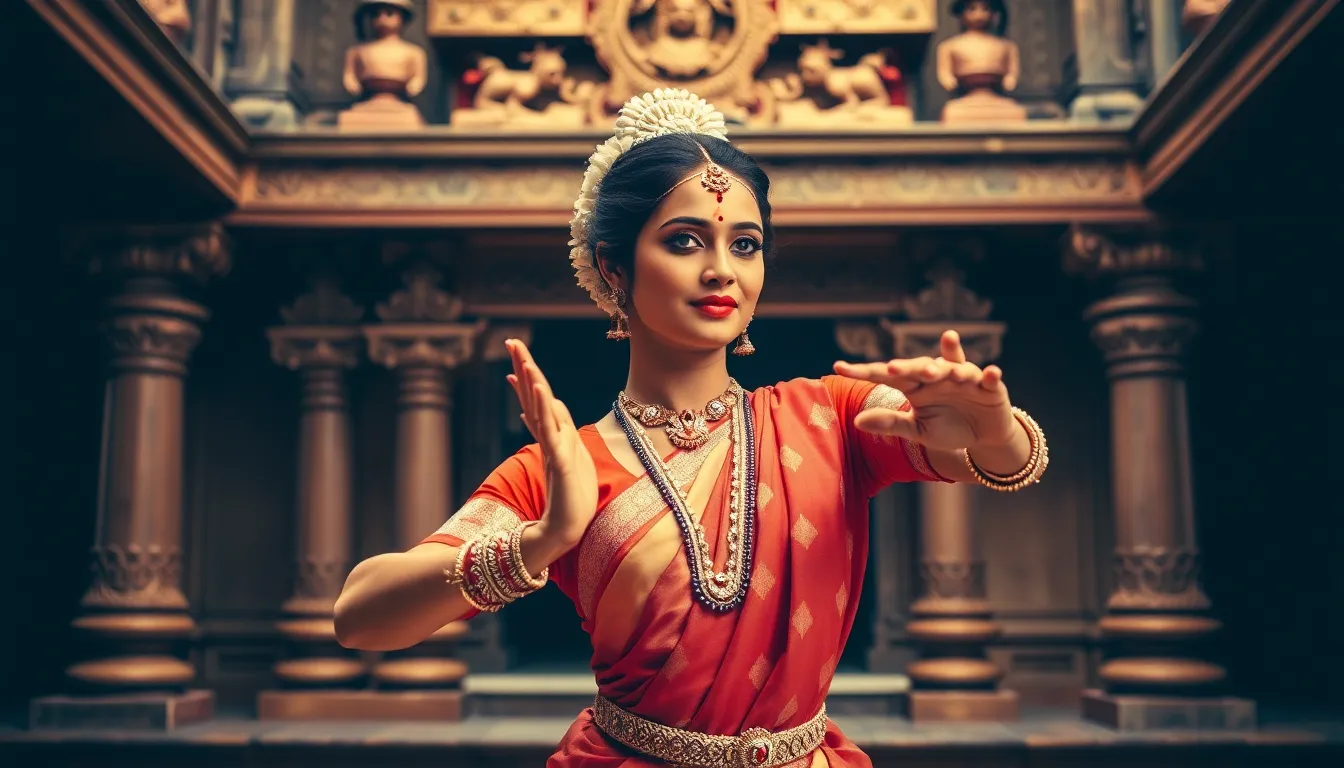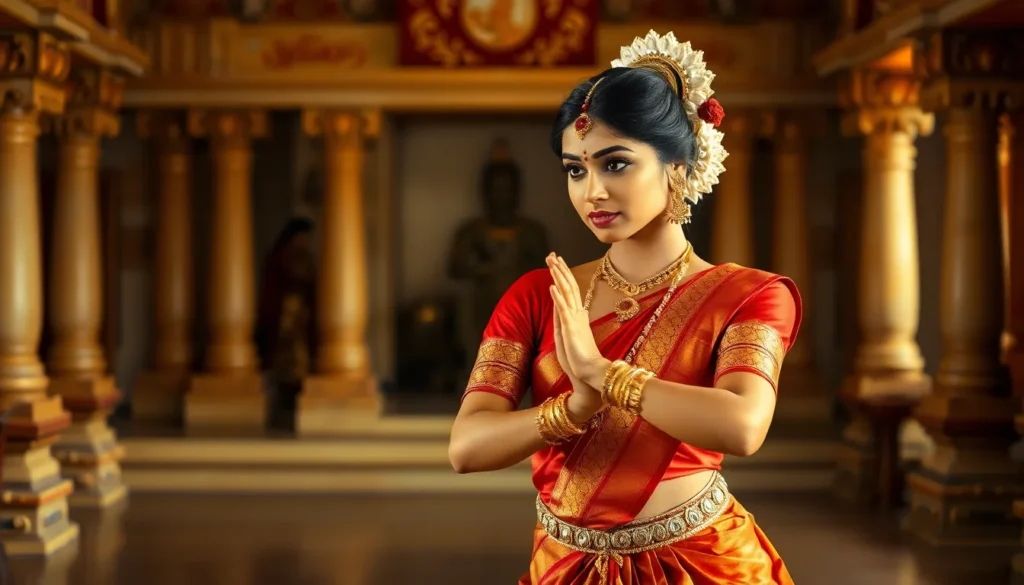Table of Contents
ToggleIn the vibrant world of Indian classical dance, few concepts are as intriguing as “nishidhasagamam.” This term, often whispered among dance enthusiasts, refers to the art of restraint and the beauty of what’s left unsaid. Imagine a dance performance where every subtle movement tells a story without uttering a single word. Intrigued yet?
Overview of Nishidhasagamam
Nishidhasagamam represents a crucial dimension of Indian classical dance, capturing the essence of restraint in performance. This art form emphasizes that movements, though subtle, can express profound emotions and tales. Intricacies in hand gestures, facial expressions, and body postures create a vocabulary of unspoken dialogue, allowing dancers to connect deeply with audiences.
Dance pieces often highlight themes such as love, devotion, or longing while utilizing this technique. Movements become poetic, immersing viewers in a narrative without uttering a single word. Each dancer interprets nishidhasagamam through personal experiences and emotional depth, adding layers to the performance.
In practice, nishidhasagamam requires intense focus and discipline. Dancers learn to master their control, ensuring that even the slightest shift in posture communicates meaning. This mastery fosters a unique connection between the performer and the audience, inviting spectators into the dancer’s world.
Choreographers integrate nishidhasagamam with traditional narratives, enhancing the storytelling aspect of their performances. Audiences find themselves drawn to the grace and beauty of these restrained movements, highlighting their significance in the overall dance form. Through this art, the language of dance transcends spoken words, affirming its power as a medium of expression.
Historical Context

Nishidhasagamam plays a critical role in the rich tapestry of Indian classical dance, tracing its roots back to ancient traditions. This art form began as a subtle method of expression, focusing on restraint and nuanced storytelling.
Origins of Nishidhasagamam
Nishidhasagamam likely emerged from spiritual and artistic practices in India. Ancient texts such as the Natya Shastra outline various techniques, emphasizing the significance of expression through movement. Practitioners initially used gestures and postures to convey emotions and narratives. The development of this style reflects the deep cultural values present in historical Indian life. Dancers sought to communicate profound themes like love, devotion, and longing, establishing a strong connection with the audience.
Evolution Over Time
As years progressed, nishidhasagamam adapted within diverse performances and regional styles. Each Indian classical dance form, such as Bharatanatyam, Kathak, and Odissi, embraced and interpreted the principles of nishidhasagamam uniquely. Over time, choreographers expanded the expressive vocabulary, incorporating modern themes while respecting traditional roots. This evolution allowed for the art form’s continued relevance, ensuring audiences engage with its profound subtleties. Techniques evolved to highlight the dancer’s inner world, reinforcing the importance of silent communication in conveying complex emotional experiences.
Key Features of Nishidhasagamam
Nishidhasagamam embodies the art of restraint in Indian classical dance, showcasing the beauty of unspoken expression. This dance form resonates through intricate movements, enhancing audience engagement.
Core Principles
Core principles of nishidhasagamam rely on subtlety and precision. Restraint emerges as a fundamental theme, enabling dancers to convey emotions without uttering a word. Each movement holds meaning, as slight changes in posture or expression amplify the narrative. Precision in gestures fosters a deeper connection with the audience, creating an unspoken dialogue. Emotionally charged themes such as love or longing manifest through controlled movements, ensuring the delivery of poignant stories. Ultimately, these principles unite to form a unique language that speaks directly to the heart.
Structure and Format
Structural elements of nishidhasagamam enhance its expressive capabilities. The format often includes clear segments that allow for distinct emotional expressions. Choreography typically integrates rhythmic patterns with dynamic formations to create visual variance. Performances showcase hand gestures, body positions, and facial expressions, each serving specific narrative functions. Variations in timing contribute to the emotional weight, ensuring impactful storytelling. Although traditional in roots, modern adaptations maintain these formats while incorporating contemporary themes, enriching the overall experience. Each aspect aligns cohesively, reinforcing the emotional narrative of the dance.
Cultural Significance
Nishidhasagamam holds profound cultural significance in Indian classical dance, intertwining artistry with societal values.
Role in Society
Restraint as expressed through nishidhasagamam reflects core societal values, emphasizing the power of subtle communication. Dancers transmit messages of love, devotion, and spirituality, reinforcing cultural narratives across generations. Social gatherings feature performances that highlight this technique, creating communal bonds and fostering appreciation for the art. Embracing this approach allows artists to convey emotions while maintaining respect for tradition. Audiences engage with the performance through shared cultural experiences, elevating the communal dimension of dance. This practice of non-verbal storytelling establishes a deep connection between dancers and viewers, enriching cultural identity.
Influence on Arts and Literature
Nishidhasagamam’s impact extends beyond dance into various artistic mediums, including literature and theater. Poets draw inspiration from its themes of restraint and emotional depth, crafting verses that evoke similar sentiments. Literature benefits from the incorporation of dance movements, where descriptions of physical expressions create vivid imagery. The interplay between dance and storytelling promotes innovation in choreographic interpretation, as narratives unfold through visual art forms. Artists explore the complexities of human emotion, influenced by nishidhasagamam’s eloquent subtleties. Through this influence, traditional dance informs contemporary works, enhancing the dialogue between disciplines while preserving cultural richness.
Contemporary Applications
Nishidhasagamam finds relevance in various domains of contemporary performance art. This art form adapts to modern sensibilities, pushing the boundaries of expression and narrative.
Modern Interpretations
Modern interpretations of nishidhasagamam embrace innovative choreography that reflects contemporary themes. Dancers incorporate elements from popular culture, merging traditional techniques with modern narratives. For instance, choreographers often blend classical styles with contemporary dance forms, creating hybrid performances. Such adaptations allow audiences to engage with age-old stories in fresh ways. Integrating technology, some performances utilize multimedia elements to heighten emotional impact. Thus, nishidhasagamam evolves while maintaining its essence, attracting diverse audiences eager to experience the depth of restraint in new contexts.
Case Studies
Several case studies illustrate nishidhasagamam’s adaptability in contemporary settings. Renowned choreographer Aditi Mangaldas explored themes of urban isolation in her recent work, using subtle facial expressions and body language. Another example includes the collaboration between Bharatanatyam dancers and contemporary artists, showcasing the power of unspoken communication. In a performance set in a bustling city, artists conveyed the juxtaposition of inner stillness against external chaos through precise movements. Such innovative approaches not only highlight nishidhasagamam’s versatility but also enhance audience connection, making the silent dialogue resonate universally.
Nishidhasagamam stands as a testament to the power of restraint in Indian classical dance. It embodies the art of conveying profound emotions through subtle movements and expressions. As dancers master this technique they not only honor tradition but also innovate within the art form, creating connections that resonate with modern audiences.
The ongoing evolution of nishidhasagamam ensures its relevance in contemporary performance art. By merging traditional elements with modern themes dancers continue to explore the depths of unspoken communication. This dynamic interplay enriches the cultural narrative while celebrating the beauty of silence in storytelling. Through nishidhasagamam the essence of dance transcends words, inviting all to appreciate its intricate beauty and emotional depth.



